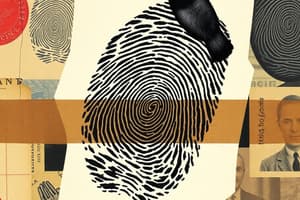Podcast
Questions and Answers
What is the primary focus of the forensic science course CJUS1301?
What is the primary focus of the forensic science course CJUS1301?
- Application of scientific methods to solve legal problems (correct)
- Understanding criminal law procedures
- Theoretical exploration of historical legal cases
- Development of personal investigative skills
Which of the following units is NOT part of the Forensic Science course outcomes?
Which of the following units is NOT part of the Forensic Science course outcomes?
- Ensure evidence is presented interactively (correct)
- Understand the roles of professionals at a crime scene
- Research new trends in forensic science
- Know the history of forensic sciences
Which activity is an important skill for forensic scientists when testifying in court?
Which activity is an important skill for forensic scientists when testifying in court?
- Creating detailed crime scene diagrams
- Explaining lab results clearly and concisely (correct)
- Interpreting police reports
- Using advanced statistical models
What is one key learner outcome of Unit I in the Forensic Science course?
What is one key learner outcome of Unit I in the Forensic Science course?
Why is an understanding of information technologies important in forensic science?
Why is an understanding of information technologies important in forensic science?
How should evidence be presented in forensic science?
How should evidence be presented in forensic science?
Which aspect of forensic science does the preservation of chain of custody primarily relate to?
Which aspect of forensic science does the preservation of chain of custody primarily relate to?
What is a significant outcome of the crime laboratory's organization?
What is a significant outcome of the crime laboratory's organization?
What is a primary function of forensic anthropology?
What is a primary function of forensic anthropology?
In what context is forensic toxicology commonly utilized?
In what context is forensic toxicology commonly utilized?
Which of the following is NOT a category of death classified in forensic pathology?
Which of the following is NOT a category of death classified in forensic pathology?
What do forensic entomologists primarily study?
What do forensic entomologists primarily study?
Which of the following best describes the role of a forensic psychologist?
Which of the following best describes the role of a forensic psychologist?
Which of the following stages of decomposition is characterized by body cooling?
Which of the following stages of decomposition is characterized by body cooling?
What is one method used in forensic toxicology for drug identification?
What is one method used in forensic toxicology for drug identification?
Which of the following is a common narcotic used in forensic investigations?
Which of the following is a common narcotic used in forensic investigations?
Which type of microscope is primarily used for comparing two samples side by side?
Which type of microscope is primarily used for comparing two samples side by side?
What is the main purpose of using a micro spectrophotometer in forensic science?
What is the main purpose of using a micro spectrophotometer in forensic science?
What is one of the key actions performed during crime scene report writing?
What is one of the key actions performed during crime scene report writing?
Which method is used for collecting biological evidence such as blood at a crime scene?
Which method is used for collecting biological evidence such as blood at a crime scene?
In forensic science, what is the importance of chain of custody?
In forensic science, what is the importance of chain of custody?
What is a primary function of a stereoscopic microscope?
What is a primary function of a stereoscopic microscope?
Which of the following best defines physical evidence in forensics?
Which of the following best defines physical evidence in forensics?
What is a common technique for documenting a crime scene before processing?
What is a common technique for documenting a crime scene before processing?
What is one of the key aspects of hair analysis in forensic science?
What is one of the key aspects of hair analysis in forensic science?
Which of the following best describes manufactured fibers?
Which of the following best describes manufactured fibers?
What are botanical remains used for in forensic analysis?
What are botanical remains used for in forensic analysis?
Which duty is NOT part of the First Responding Officer's responsibilities?
Which duty is NOT part of the First Responding Officer's responsibilities?
What is primarily documented through the use of photography at a crime scene?
What is primarily documented through the use of photography at a crime scene?
What method of assessment accounts for 30% of the overall course evaluation?
What method of assessment accounts for 30% of the overall course evaluation?
Which of the following is a method used for delivering instruction in this course?
Which of the following is a method used for delivering instruction in this course?
What is a common challenge when analyzing pollen samples in forensic botany?
What is a common challenge when analyzing pollen samples in forensic botany?
Flashcards
Forensic Science
Forensic Science
The application of scientific knowledge to legal matters, including civil and criminal cases. This field uses scientific techniques to analyze evidence and solve crimes.
Branches of Forensic Science
Branches of Forensic Science
Different specialized areas within forensic science, each focusing on a specific type of evidence or analysis. Examples include trace evidence analysis, DNA analysis, and ballistics.
Crime Laboratory
Crime Laboratory
A facility equipped with specialized labs and instruments to analyze and interpret evidence collected from crime scenes. It plays a crucial role in criminal investigations.
Forensic Scientist
Forensic Scientist
Signup and view all the flashcards
Chain of Custody
Chain of Custody
Signup and view all the flashcards
Crime Scene Investigation
Crime Scene Investigation
Signup and view all the flashcards
Information Technologies in Forensic Science
Information Technologies in Forensic Science
Signup and view all the flashcards
Courtroom Testimony
Courtroom Testimony
Signup and view all the flashcards
Forensic Anthropology
Forensic Anthropology
Signup and view all the flashcards
Forensic Odontology
Forensic Odontology
Signup and view all the flashcards
Forensic Pathology: Decomposition
Forensic Pathology: Decomposition
Signup and view all the flashcards
Forensic Toxicology
Forensic Toxicology
Signup and view all the flashcards
Criminal Profiling
Criminal Profiling
Signup and view all the flashcards
Computer and Mobile Forensics
Computer and Mobile Forensics
Signup and view all the flashcards
Mental Deviance
Mental Deviance
Signup and view all the flashcards
Criminal Profiling
Criminal Profiling
Signup and view all the flashcards
Compound Microscope
Compound Microscope
Signup and view all the flashcards
Stereoscopic Microscope
Stereoscopic Microscope
Signup and view all the flashcards
Polarizing Microscope
Polarizing Microscope
Signup and view all the flashcards
Scanning Electron Microscope (SEM)
Scanning Electron Microscope (SEM)
Signup and view all the flashcards
Crime Scene Documentation
Crime Scene Documentation
Signup and view all the flashcards
Evidence Collection & Chain of Custody
Evidence Collection & Chain of Custody
Signup and view all the flashcards
Biological Evidence
Biological Evidence
Signup and view all the flashcards
Physical Evidence
Physical Evidence
Signup and view all the flashcards
First Responding Officer
First Responding Officer
Signup and view all the flashcards
Crime Scene Photography
Crime Scene Photography
Signup and view all the flashcards
Legal Considerations at the Crime Scene
Legal Considerations at the Crime Scene
Signup and view all the flashcards
Trace Evidence
Trace Evidence
Signup and view all the flashcards
Trace Evidence Analysis
Trace Evidence Analysis
Signup and view all the flashcards
Hair Comparison
Hair Comparison
Signup and view all the flashcards
Fibers
Fibers
Signup and view all the flashcards
Study Notes
Forensic Science Course
- Course Name: Forensic Science
- Course Code: CJUS1301
- Credits: 3
- Contact Hours: 75 (45 practical, 30 theory)
- Pre-requisites: None
- Co-requisites: None
- Semester: Not specified
- Course Description: Applies scientific knowledge to civil and criminal legal issues. Learners will explore methods used by forensic scientists, learn analysis techniques, and understand the significance of results in reports.
- Course Outcomes: Students should be able to:
- Understand the history and development of forensic science, including its presence in popular culture.
- Understand the roles of professionals involved in crime scene evaluation and evidence collection.
- Understand methods of evidence collection and interpretation, avoiding contamination, and maintaining chain of custody.
- Present evidence in a professional manner
- Apply forensic science principles and concepts.
- Research and understand new and emerging trends in forensic science.
Unit I: Introduction to Forensic Science
- Learner Outcomes: Able to:
- Understand different sub-fields and emerging techniques in forensic science.
- Understand crime lab organization structure for effective use.
- Explore forensic disciplines through research.
- Assess roles and functions of forensic scientists and crime labs.
- Understand the role of information technology in forensic science, including computer and mobile forensics.
Unit II: Forensic Psychology
- Learner Outcomes: Able to:
- Assess a suspect's mental state at the time of a crime.
- Evaluate suspect behavioral patterns.
- Assess suspect's modus operandi.
Unit III: Forensic Anthropology
- Learner Outcomes: Able to:
- Understand forensic odontology and its uses in criminal and archaeological cases.
- Identify isolated or fragmentary bones for archaeological and forensic purposes.
Unit IV: Forensic Pathology
- Learner Outcomes: Able to:
- Classify types of death in a forensic context.
- Examine cadavers in a forensic context.
- Understand the process of decomposition in forensic applications.
- Analyze a body to determine time of death.
Unit V: Forensic Toxicology
- Learner Outcomes: Able to:
- Understand general concepts of forensic toxicology, including pharmacokinetics and pharmacodynamics.
- Identify various drugs used in forensic applications.
Unit VI: Microscopy and Forensic Science
- Learner Outcomes: Able to:
- Use various types of microscopes.
- Analyze evidence samples using appropriate microscopes (Compound, Comparison, Stereoscope, Polarizing, Micro spectrophotometer, SEM)
Unit VII: Recording a Crime Scene
- Learner Outcomes: Able to:
- Use contemporary photographic techniques to document crime scenes.
- Prepare a comprehensive crime scene report.
- Prepare a crime scene sketch.
Unit VIII: Evidence Collection and Chain of Custody
- Learner Outcomes: Able to:
- Differentiate types of physical evidence.
- Collect and package physical evidence according to forensic standards.
- Collect and package cadavers according to forensic standards.
Unit IX: Hair and Fiber Evidence
- Learner Outcomes: Able to:
- Identify hair and fiber samples from a crime scene.
- Analyze hair, fiber and botanical samples.
Unit X: The Crime Scene
- Learner Outcomes: Able to:
- Understand duties and responsibilities of first responders at a crime scene.
- Apply techniques for securing and documenting crime scenes.
- Use photography to document, record, and preserve crime scenes.
Studying That Suits You
Use AI to generate personalized quizzes and flashcards to suit your learning preferences.




